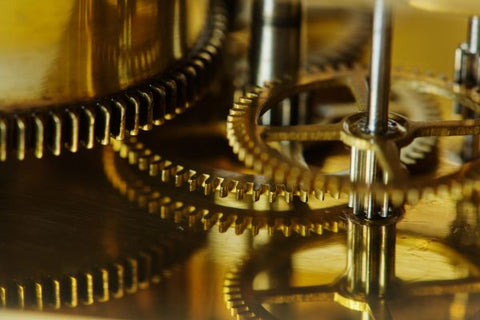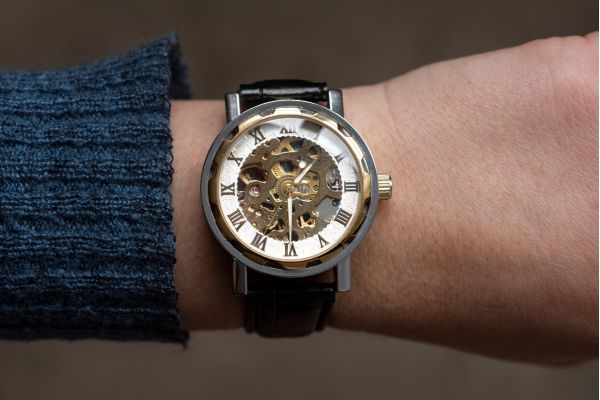Summary
- What is a mechanical watch?
- The key components of a mechanical watch for its proper functioning
- The careful assembly of the components
- Mechanical and automatic watches: what are the differences?
- Some tips for choosing the right watch
The mechanical watch fascinates with its history, engineering and timeless elegance. How does it work without a battery? How many parts are there in it? These questions intrigue both amateurs and enthusiasts.
What is a mechanical watch?
A mechanical watch is a timepiece that operates without electronics, relying solely on a complex system of gears, springs, and cogs. Unlike battery-powered watches, which use an electronic circuit and a quartz oscillator to measure time, mechanical watches draw their energy from a mainspring that must be wound regularly. They embody both the technical mastery of watchmakers and a deep respect for the heritage of craftsmanship, making them much more than just functional instruments.
The key components of a mechanical watch for its proper functioning
Each mechanical watch is a technical feat, where meticulously designed parts work together to bring a precise mechanism to life. These components, both functional and aesthetic, illustrate all the expertise of watchmakers and each play an essential role in the harmonious functioning of this fascinating object.
The mainspring: the energetic heart
The mainspring, or main spring, is a metal ribbon wound in a barrel. When wound, it is tensioned to gradually release the energy needed for the movement. A stable tension is essential to preserve the precision of the watch. Watchmakers optimize its design for a constant energy distribution.
The gear train: the transmission of energy
The gear train transmits the power from the mainspring to the balance spring. It consists of a set of toothed wheels that gradually reduce the rotation speed. Each wheel is precisely designed to ensure reliable time measurement.
The exhaust: a regulating mechanism

At the heart of the functioning of a mechanical watch, the escapement plays a central role. It acts as the guardian of precision by regulating the release of energy accumulated by the mainspring. By balancing each movement, this complex device guarantees the smooth running and reliability of the watch.
This pendulum device guarantees reliable time measurement. High-end watches display drifts of only a few seconds per day, despite the total absence of electronics.
The balance spring: cadence and precision
The sprung balance wheel oscillates at variable frequencies, often between 18,000 and 36,000 vibrations per hour. This regular movement marks the seconds and ensures the fluidity characteristic of mechanical watches.
The careful assembly of the components
Understanding the composition of a mechanical watch is like diving into the heart of a true feat of engineering. Each element, whether visible or hidden, plays an essential role in ensuring the perfect functioning of this timeless object.
A universe of engineering
Standard mechanical watches consist of around 100 parts, while complex models can have up to 300. Every element, from the smallest gear to the tiniest screw, is designed to minimise friction and optimise energy transfer.
The importance of materials
High-quality gold, platinum or steel are preferred for the cases. Synthetic rubies reduce wear on the pivots. With proper care, these watches can last for generations.
Mechanical and automatic watches: what are the differences?
Mechanical watches are distinguished by their battery-free operation, relying solely on a system of gears and springs. Among them, we find manual watches, which require regular winding of the crown, a ritual that strengthens the unique bond with their wearer. Automatic watches, which are also mechanical watches, include a rotor that recharges the mainspring with each movement of the wrist. This feature combines practicality and the magic of pure mechanics, while sharing the traditional essence of mechanical watches. To learn more, Luxury Mods offers you a complete article on the operation of automatic watches, including the Submariner , the GMT Master II or the Rolex Datejust .
Some tips for choosing the right watch
Choosing a mechanical watch often relies on aesthetic and technical criteria. This could be a dial style, case diameter, or even nighttime visibility. However, it is essential to check the power reserve and balance frequency, as these parameters directly influence accuracy. High-frequency watches tend to be more stable, but sometimes require more maintenance.
Water resistance is a determining factor if you engage in aquatic activities or live in a humid environment. Although some mechanical watches boast water resistance records, it is recommended to have them checked regularly by a watchmaker, especially if you expose them to seawater or sudden changes in temperature.
The mechanical watch is a masterpiece of engineering, combining precision, elegance and heritage. Understanding its mechanisms means appreciating a timeless art where every second counts.


What are the characteristics of Japanese watches?
What is the NH34 movement?